Host: Fraser Cain (@fcain)
Guests: Morgan Rehnberg (cosmicchatter.org / @cosmic_chatter), Brian Koberlien (@briankoberlein)
Continue reading “Weekly Space Hangout – May 30, 2014: Gamma Ray Burst? Maybe Not?”
Weekly Space Hangout – April 25, 2014: Asteroids, ISS Repairs & an Annular Eclipse
Host: Fraser Cain
Guests: Morgan Rehnberg, Brian Koberlein, David Dickinson, Jason Major
This Week’s Stories:
Morgan Rehnberg (cosmicchatter.org / @cosmic_chatter):
EVA
Cosmos
SpaceX announcements
Brian Koberlein (@briankoberlein, briankoberlein.com):
Meteors are not more likely to hit Earth
Dave Dickinson (@astroguyz, www.astroguyz.com):
Saturn at Opposition
Bizarre Annular Eclipse
Jason Major (@JPMajor, LightsInTheDark.com):
B612 Foundation asteroid announcement
We record the Weekly Space Hangout every Friday at 12:00 pm Pacific / 3:00 pm Eastern. You can watch us live on Google+, Universe Today, or the Universe Today YouTube page.
Curiosity Captures First Ever Asteroid Images from Mars Surface
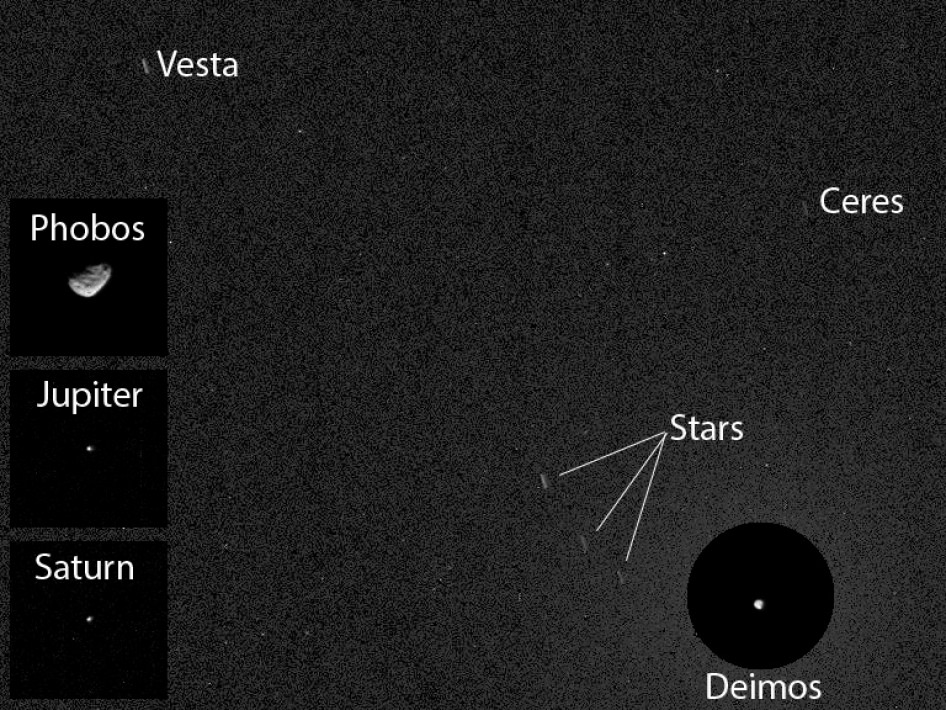
NASA’s Curiosity Mars rover has caught the first image of asteroids taken from the surface of Mars on April 20, 2014. The image includes two asteroids, Ceres and Vesta. This version includes Mars’ moon Deimos in a circular, exposure-adjusted inset and square insets at left from other observations the same night. Credit: NASA/JPL-Caltech/MSSS/Texas A&M
More night sky views and surface mosaics below[/caption]
The Curiosity rover has captured the first images of asteroids even taken by a Human probe from the alien surface of the Red Planet during night sky imaging.
And it’s not just one asteroid, but two asteroids caught in the same night time pointing on the Red Planet. Namely, asteroids Ceres and Vesta.
The stupendous image – seen above – was snapped by Curiosity’s high resolution Mastcam camera earlier this week on Sunday, April 20, 2014, Sol 606, whilst she was scanning about during daylight for her next drilling target at “The Kimberley” waypoint she pulled into at the start of this month.
Ceres and Vesta appear as streaks since the Mastcam image was taken as a 12 second time exposure.
“This imaging was part of an experiment checking the opacity of the atmosphere at night in Curiosity’s location on Mars, where water-ice clouds and hazes develop during this season,” said camera team member Mark Lemmon of Texas A&M University, College Station, in a statement.
“The two Martian moons were the main targets that night, but we chose a time when one of the moons was near Ceres and Vesta in the sky.”
View our “Kimberley” region photo mosiacs below to see exactly from where the six wheeled robot took the asteroid image shown above, while driving around the base of “Mount Remarkable”.
And those two asteroids are extra special because not only are they the two most massive objects in the Main asteroid belt between Mars and Jupiter, but they are also the destinations of another superlative NASA unmanned mission – Dawn.
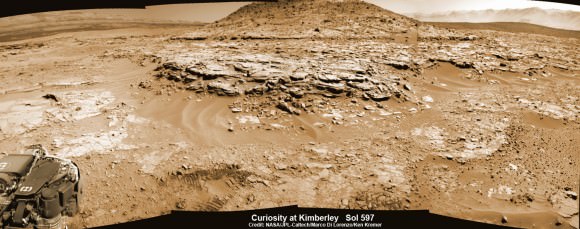
The exotic Dawn probe, propelled by a stream of ions, orbited Vesta for a year in 2011 and is now approaching Ceres for an exciting orbital mission in 2015.
Ceres, the largest asteroid, is about 590 miles (950 kilometers) in diameter. Vesta is the third-largest object in the main belt and measures about 350 miles (563 kilometers) wide.
And as if Curiosity’s mouthwatering and heavenly double asteroid gaze wasn’t already spectacular enough, the tinier of Mars’ moons, Deimos, was also caught in that same image.
A trio of star trails is also seen, again due to the 12 second time exposure time.
Furthermore, Mars largest moon Phobos as well as massive planets Jupiter and Saturn were also visible that same Martian evening, albeit in a different pointing.
These celestial objects are all combined in the composite image above.
“The background is detector noise, limiting what we can see to magnitude 6 or 7, much like normal human eyesight. The two asteroids and three stars would be visible to someone of normal eyesight standing on Mars. Specks are effects of cosmic rays striking the camera’s light detector,” says NASA.
An unannotated image is seen below.
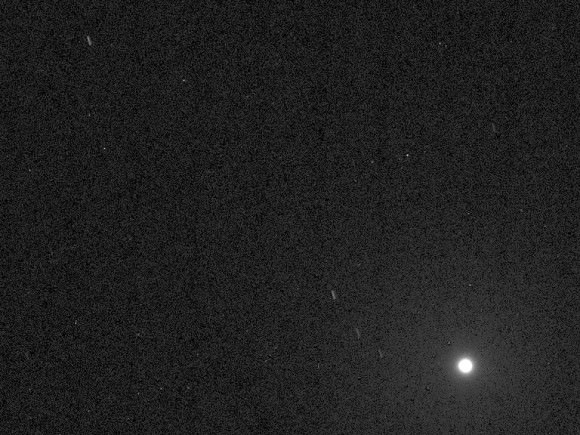
Curiosity’s makers back on Earth are nowhere to be seen. But check out the Curiosity’s earlier photo below of the Earth and Moon from my prior article – here.
To date, Curiosity’s odometer totals 3.8 miles (6.1 kilometers) since landing inside Gale Crater on Mars in August 2012. She has taken over 143,000 images.
The sedimentary foothills of Mount Sharp, which reaches 3.4 miles (5.5 km) into the Martian sky, is the 1 ton robots ultimate destination inside Gale Crater because it holds caches of water altered minerals. Such minerals could possibly indicate locations that sustained potential Martian life forms, past or present, if they ever existed.
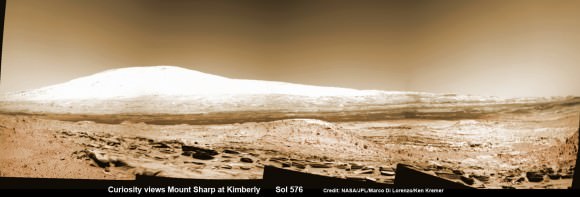
Curiosity has some 4 kilometers to go to reach the base of Mount Sharp sometime later this year.
Stay tuned here for Ken’s continuing Curiosity, Opportunity, Chang’e-3, SpaceX, Orbital Sciences, LADEE, MAVEN, MOM, Mars and more planetary and human spaceflight news.
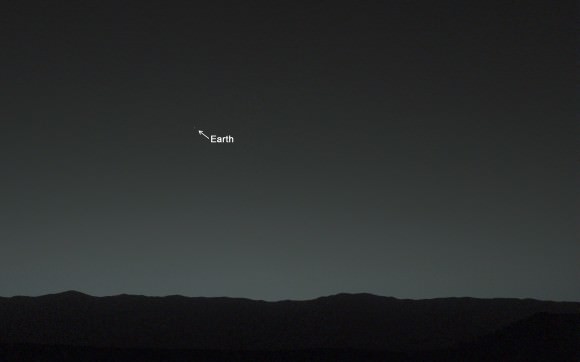
This evening-sky view taken by NASA’s Mars rover Curiosity shows the Earth and Earth’s moon as seen on Jan. 31, 2014, or Sol 529 shortly after sunset at the Dingo Gap inside Gale Crater. Credit: NASA/JPL-Caltech/MSSS/TAMU
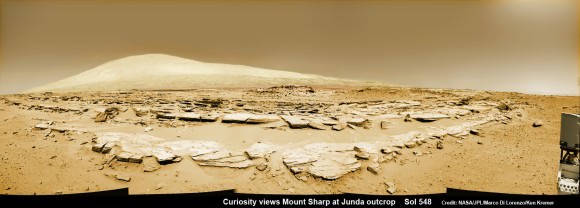
Asteroids VS. Your Hometown: Fun but Frightening Graphics Compare Asteroid Sizes to Places on Earth
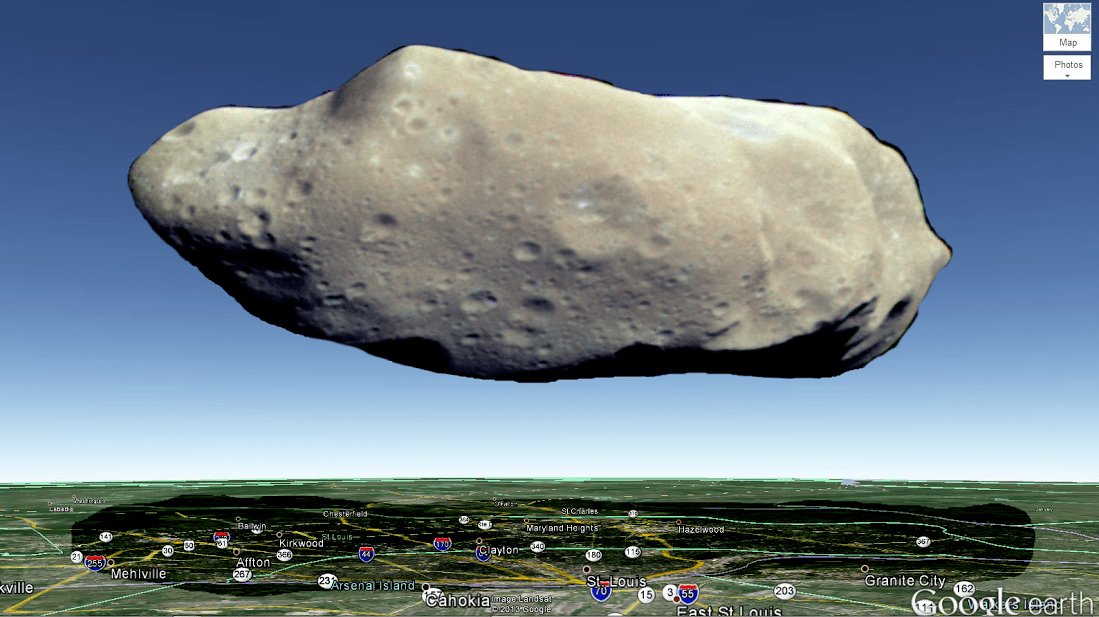
So, how big is that space rock?
Sometimes when I see data on sizes and distances in relation to stuff out in space, it’s hard to get a frame of reference, since those two categories tend to lean towards the super-big. But now, I’ve got a little help. Space enthusiast and software engineer Ciro Villa has brought some of these references closer to home with these fun graphics that provide accurate size ratios and proportions of objects in space compared to places on Earth.
Villa calls these graphics “hovering celestial objects” and while all of these scenarios are impossible in real life, he’s placed large asteroids and moons next to Earthly locations to provide a good frame of reference for dimensions. Please note that most of these objects have absolutely no chance of colliding with Earth as they are not anywhere near our neighborhood and are not expected to visit it either.
“My representations are is purely for illustrative purposes,” Villa said. “I have maintained the size ratios and proportions as accurately as possible just to demonstrate the dimensions. This is mostly a ‘fun’ exercise.”
For example, I regularly drive through the St. Louis, Missouri metro area, so I have a sense of how big it is. Above, Villa places Asteroid 243 Ida — which has an average diameter of 31.4 km (19.5 miles) — to hover right above St. Louis. 31 km is about the distance from East St. Louis, Illinois to Creve Coeur, Missouri, which are the generally accepted eastern and western borders of the St. Louis metro area. I could probably drive across Ida in about 30 minutes — if it’s not rush hour, that is!
To create these graphics, Villa uses Google Maps, NASA data and Gimp image editing software. Again, these graphics are for fun, but I really find them useful!
And Villa provided a caveat: “Please note that I am not a professional graphic artist, so I’m sure people are going to find plenty of imperfections in these depictions,” he said. “The important point I am trying to convey is mainly the size dimensions comparing with a known area of Earth.”
Here are more:
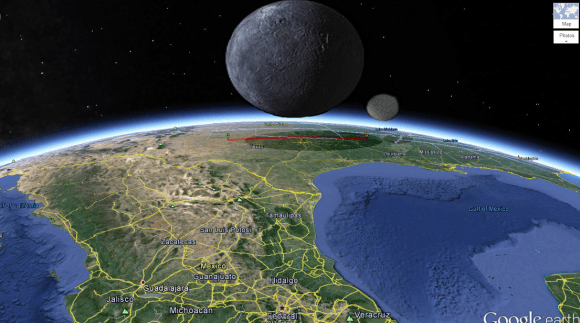
Here are a bigger pair of objects in comparison to an area of Eastern Texas and Western Arkansas. 90482 Orcus is a trans-Neptunian Kuiper belt object that is about 800 kilometers in diameter. Orcus has a fairly large moon orbiting it named Vanth, which is about 300 km in diameter.
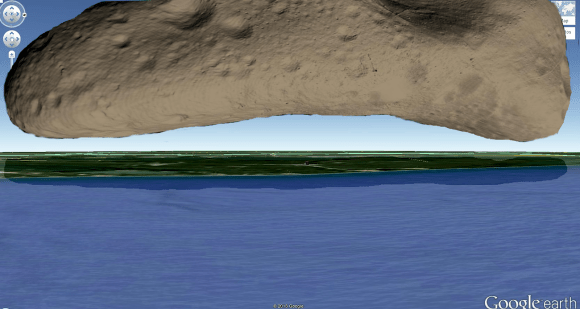
This asteroid might pay Earth a close visit, but not for a couple of million years. Eros is the second largest NEO (Near Earth Object), with a diameter of approximately 34 kilometers, and here Villa imagines Eros centered over the VAB (Vehicle Assembly Building) at Cape Canaveral, covering the Cape area from approximately the southern end of the Canaveral National Seashore to the Pine Island Conservation area, with the VAB in about the middle, as the crow (or sandhill crane) flies.
While Eros is technically an NEO, it made one of its closest passes of Earth in 2012 of 16.6 million miles (26.7 million km) and won’t pass that close again until 2056. A look ahead with orbital mechanics suggests that Eros may move to an Earth-crossing orbit in about two million years, given the right perturbations by gravitational interactions.
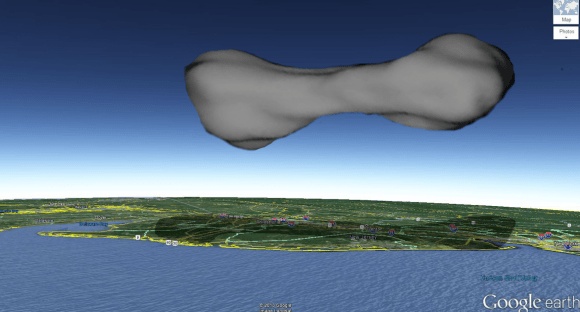
And to show the scale of several moons in our Solar System, Villa made these comparisons:
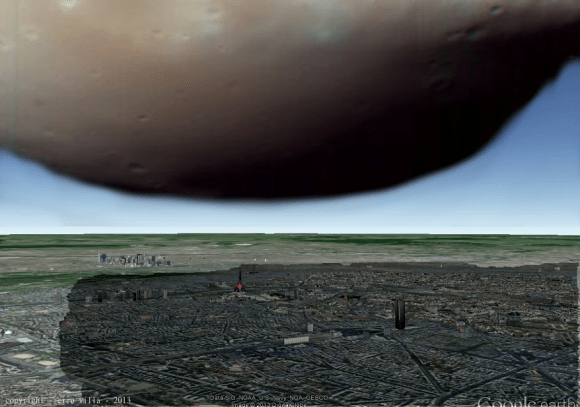
“Deimos is about 15 kilometers across, so I have measured a portion of the city of Paris, France of about 5 Kilometers and properly scaled Deimos,” Villa said. “For added dramatics, I have purposely shown enough of Deimos hovering to show about 5 kilometers of Paris, to show some of the landmarks (notice the Eiffel tower). Had I decided to show all of Deimos, the scale would have been too large to recognize any of the landmarks of Paris.”
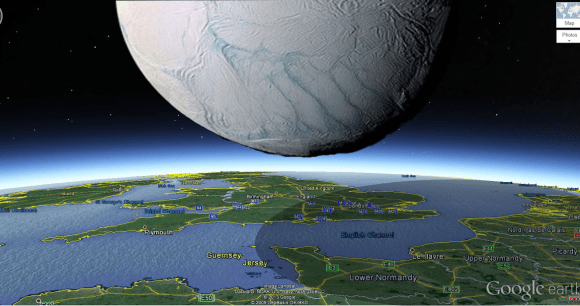
Continuing these imaginary montages, here is one of our favorite moons, Enceladus, with an approximate diameter of about 500 kilometers, seen drifting over Southern England. That’s about the same distance from Plymouth to Leigh-on-the-Sea in the UK.
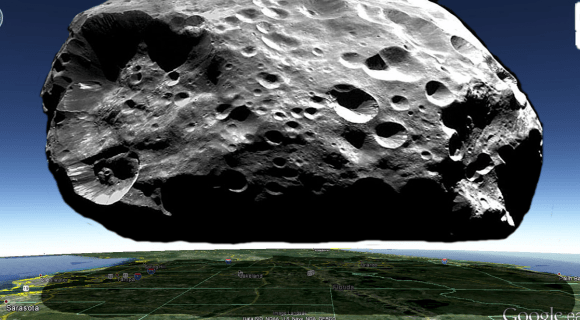
This last one is a bit personal for Villa, since he lives in Florida. Here, Saturn’s moon Phoebe hangs over Central Florida. “Phoebe shares an approximate diameter of 200 kilometers with the central portion of the state,” Villa said, “and I wanted to ‘play’ with my imagination a bit!”
Thanks to Ciro Villa for sharing his “hovering celestial objects” with Universe Today. Check out his informative and entertaining G+ feed here.
Astronauts to Reveal Sobering Data on Asteroid Impacts

This Earth Day, Tuesday, April 22, three former NASA astronauts will present new evidence that our planet has experienced many more large-scale asteroid impacts over the past decade than previously thought… three to ten times more, in fact. A new visualization of data from a nuclear weapons warning network, to be unveiled by B612 Foundation CEO Ed Lu during the evening event at Seattle’s Museum of Flight, shows that “the only thing preventing a catastrophe from a ‘city-killer’ sized asteroid is blind luck.”
Since 2001, 26 atomic-bomb-scale explosions have occurred in remote locations around the world, far from populated areas, made evident by a nuclear weapons test warning network. In a recent press release B612 Foundation CEO Ed Lu states:
“This network has detected 26 multi-kiloton explosions since 2001, all of which are due to asteroid impacts. It shows that asteroid impacts are NOT rare — but actually 3-10 times more common than we previously thought. The fact that none of these asteroid impacts shown in the video was detected in advance is proof that the only thing preventing a catastrophe from a ‘city-killer’ sized asteroid is blind luck. The goal of the B612 Sentinel mission is to find and track asteroids decades before they hit Earth, allowing us to easily deflect them.”
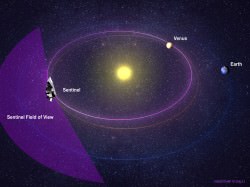
The B612 Foundation is partnered with Ball Aerospace to build the Sentinel Infrared Space Telescope Mission. Once positioned in solar orbit closer to the Sun from Earth, Sentinel will look outwards in infrared to detect hundreds of thousands of as-yet unknown near-Earth objects over 140 meters in size. The privately-funded spacecraft is slated to launch in 2017-18 aboard a SpaceX Falcon 9 rocket.
In addition to Lu, Space Shuttle astronaut Tom Jones and Apollo 8 astronaut Bill Anders will be speaking at the event, titled “Saving the Earth by Keeping Big Asteroids Away.”
The event will be held at 6 p.m. PDT at the Museum of Flight in Seattle, WA. It is free to the public and the visualization will be made available online on the B612 Foundation website.
Want to support the Sentinel mission? Donate online here.
Why the Asteroid Belt Doesn’t Threaten Spacecraft
When you think of the asteroid belt, you probably imagine a region of rock and dust, with asteroids as far as the eye can see. Such a visual has been popularized in movies, where spaceships must swerve left and right to avoid collisions. But a similar view is often portrayed in more scientific imagery, such as the artistic rendering above. Even the first episode of the new Cosmos series portrayed the belt as a dense collection of asteroids. But the reality is very different. In reality the asteroid belt is less cluttered than often portrayed. Just how much less might surprise you.
The Sloan digital sky survey (SDSS) has identified more than 100,000 asteroids in the solar system. Not all of these lie within the asteroid belt, but there are about 80,000 asteroids in the belt larger than a kilometer. Of course there are asteroids smaller than that, but they are more difficult to detect, so we aren’t exactly sure how many there are.
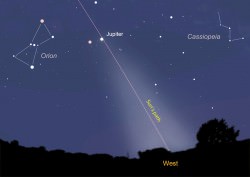
We have a pretty good idea, however, because the observations we have indicate that the size distribution of asteroids follows what is known as a power law distribution. For example, with a power law of 1, for every 100-meter wide asteroid there would be 10 with a diameter of 10 meters and 100 with a diameter of 1 meter. Based upon SDSS observations, asteroids seem to follow a power law of about 2, which means there are likely about 800 trillion asteroids larger than a meter within the belt. That’s a lot of rock. So much that sunlight scattering off the asteroid belt and other dust in the solar system is the source of zodiacal light.
But there is also a lot of volume within the asteroid belt. The belt can be said to occupy a region around the Sun from about 2.2 to 3.2 times the distance from the Earth to the Sun from the Sun (AU), with a thickness of about 1 AU. A bit of math puts that at about 50 trillion trillion cubic kilometers. So even though there are trillions of asteroids, each asteroid has billions of cubic kilometers of space on average. The asteroid belt is hardly something you would consider crowded. It should be emphasized that asteroids in the belt are not evenly distributed. They are clustered into families and groups. But even such clustering is not significant compared to the vast space it occupies.
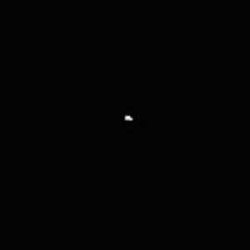
Credit: NASA
You can even do a very rough calculation to get an idea of just how empty the asteroid belt actually is. If we assumed that all the asteroids lay within a single plane, then on average there is 1 asteroid within an area roughly the size of Rhode Island. Within the entire United States there would be about 2000 asteroids, most of them only a meter across. The odds of seeing an asteroid along a cross-country road trip, much less hitting one, would be astoundingly small. So you can see why we don’t worry about space probes hitting an asteroid on their way to the outer solar system. In fact, to get even close to an asteroid takes a great deal of effort.
Weekly Space Hangout – March 7, 2014: Cosmos Premiere & NASA Budget
Host: Fraser Cain
Astrojournalists: David Dickinson, Matthew Francis, Casey Dreier, Jason Major, Brian Koberlein, Alan Boyle
This week’s stories:
Alan Boyle (@b0yle, cosmiclog.com ):
Cosmos premiere!
David Andrew Dickinson (@astroguyz):
Watch the Close Pass of NEO 2014 DX110
Daylight Saving time: A Spring Forward or a Step Back?
A Natural Planetary Defense Against Solar Storms
Matthew Francis (@DrMRFrancis, BowlerHatScience.org):
Using gravitational lensing to measure a spinning quasar
CosmoAcademy classes
Casey Dreier (Planetary.org):
The 2015 NASA Budget Request
NASA Kinda Embraces Exploring Europa
Jason Major (@JPMajor, LightsInTheDark.com):
That’s the way the asteroid crumbles
Brian Koberlein (@briankoberlein, briankoberlein.com):
*Possible* evidence for dark matter WIMPs
Black Holes exceed Eddington limit
Using quasars in a quantum experiment
We record the Weekly Space Hangout every Friday at 12:00 pm Pacific / 3:00 pm Eastern. You can watch us live on Google+, Universe Today, or the Universe Today YouTube page.
Hubble Telescope Watches Asteroid Disintegrate in Space

Back in 2010, astronomers discovered an asteroid that was breaking apart due to a head-on collision with another asteroid. But now they have seen an asteroid break apart – with no recent collision required.
Asteroid P/2013 R3 appears to be crumbling apart in space, and astronomers using the Hubble Space Telescope recently saw the asteroid breaking into as many as 10 smaller pieces. The best explanation for the break-up is the Yarkovsky–O’Keefe–Radzievskii–Paddack (YORP) effect, a subtle effect from sunlight that can change the asteroid’s rotation rate and basically cause a rubbly-type asteroid to spin apart.
“This is a really bizarre thing to observe — we’ve never seen anything like it before,” said co-author Jessica Agarwal of the Max Planck Institute for Solar System Research, Germany. “The break-up could have many different causes, but the Hubble observations are detailed enough that we can actually pinpoint the process responsible.”
Astronomers first noticed this asteroid on September 15, 2013 and it appeared as a weird, fuzzy-looking object, as seen by the Catalina and Pan-STARRS sky-survey telescopes. A follow-up observation on Oct. 1 with the W.M. Keck telescope on Hawaii’s Mauna Kea revealed three co-moving bodies embedded in a dusty envelope that is nearly the diameter of Earth.
Then on October 29, 2013, astronomers used the Hubble Space Telescope to observe the object and saw there were actually 10 embedded objects, each with comet-like dust tails. The four largest rocky fragments are up to 200 meters/yards in radius, about twice the length of a football field.
The Hubble data showed that the fragments are drifting away from each other at a leisurely pace of 1.6 km/hr (one mile per hour), which would be slower than a strolling human.
“Seeing this rock fall apart before our eyes is pretty amazing,” said David Jewitt, from UCLA’s Department of Physics and Astronomy, who led the investigation.
The slowness of the speed at which the pieces are coming apart makes it unlikely that the asteroid is disintegrating because of a collision. That would be instantaneous and violent, with the pieces traveling away from each other at much higher speeds.
Jewitt also said the asteroid is not coming unglued due to the pressure of interior ices warming and vaporizing, like comets do as they approach the Sun. The asteroid is too cold for ices to significantly sublimate, and it has presumably maintained its nearly 480 million-km (300 million–mile) distance from the Sun for much of its life.
Jewitt described the YORP torque effect as like grapes on a stem being gently pulled apart due to centrifugal force of an unusually shaped asteroid as it speeds up in its spin. This effect occurs when light from the Sun is absorbed by a body and then re-emitted as heat. When the shape of the emitting body is not perfectly regular, more heat is emitted from some regions than others. This creates a small imbalance that causes a small but constant torque on the body, which changes its spin rate. This effect has been discussed by scientists for several years but, so far, never reliably observed.
For the break-up to happen, P/2013 R3 must have a weak, fractured interior, probably as the result of previous but ancient collisions with other asteroids. Most small asteroids, in fact, are thought to have been severely damaged in this way, giving them a “rubble pile” internal structure. P/2013 R3 itself is probably the product of collisional shattering of a bigger body some time in the last billion years.
With Hubble’s recent discovery of an a different active asteroid spouting six tails (P/2013 P5), astronomers are seeing more circumstantial evidence that the pressure of sunlight may be the primary force that disintegrates small asteroids (less than a mile across) in the Solar System.
The asteroid’s remnant debris, estimated at weighing in at 200,000 tons, in the future will provide a rich source of meteoroids, Jewitt said. Most will eventually plunge into the sun, but a small fraction of the debris may one day enter the Earth’s atmosphere to blaze across the sky as meteors, he said.
The discovery is published online March 6 in Astrophysical Journal Letters. A preprint of the paper can be found here.
Sources: UCLA, Hubble ESA
Watch a Car-Sized Asteroid Slam Into the Moon
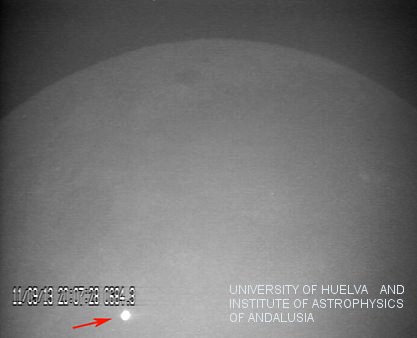
Hey, all you astro-photographers/videographers out there: were you shooting the Moon back on September 11, 2013? You may want to review your footage and see if you captured a bright flash which occurred at about 20:07 GMT. Astronomers say a meteorite with the mass of a small car slammed into the Moon at that time and the impact produced a bright flash, and it even would have been easy to spot from the Earth.
According to astronomers Jose M. Madiedo, from the University of Huelva and Jose L. Ortiz, from the Institute of Astrophysics of Andalusia both in Spain, this impact was the longest and brightest confirmed lunar impact flash ever observed, as the “afterglow” of the impact remained visible for 8 seconds.
The astronomers think the bright flash was produced by an impactor of around 400 kg with a width of between 0.6 and 1.4 meters. The rock hit may have hit Mare Nubium at about 61,000 kilometers per hour (38,000 miles per hour) — although the uncertainty of the impact is fairly high, the team says in their paper. But if it is as high as they think, it may have created a new crater with a diameter of around 40 meters. The impact energy was equivalent to an explosion of roughly 15 tons of TNT.
This beats the previous largest impact seen – which occurred just six months earlier in March 2013 – which was estimated to pack as much punch as 5 tons of TNT. Astronomers that explosion was caused by a 40 kg meteoroid measuring 0.3 to 0.4 meters wide, traveling about 90,000 km/hr (56,000 mph.)
How often does an asteroid hit the Moon? Astronomers actually aren’t very sure.
On average, 33 metric tons (73,000 lbs) of meteoroids hit Earth every day, the vast majority of which harmlessly ablates or burns up high in Earth’s atmosphere, never making it to the ground. The Moon, however, has little or no atmosphere, so meteoroids have nothing to stop them from striking the surface.
The lunar impact rate is so uncertain because observations for objects in the mass range of visible impacts from Earth are quite few. But now, astronomers have set up networks of telescopes that can detect them automatically. NASA has the Automated Lunar and Meteor Observatory (ALaMO) at Marshall Space Flight Center, and the Spanish telescopes are part of the Moon Impacts Detection and Analysis System (MIDAS) system.
Lunar meteors hit the ground with so much kinetic energy that they don’t require an oxygen atmosphere to create a visible explosion. The flash of light comes not from combustion but rather from the thermal glow of molten rock and hot vapors at the impact site.
This thermal glow can be detected from Earth as short-duration flashes through telescopes. Generally, these flashes last just a fraction of a second. But the flash detected on September 11, 2013 was much more intense and longer than anything observed before.

“Our telescopes will continue observing the Moon as our meteor cameras monitor the Earth’s atmosphere,” said Madiedo and Ortiz in a press release. “In this way we expect to identify clusters of rocks that could give rise to common impact events on both planetary bodies. We also want to find out where the impacting bodies come from.”
You can read the team’s paper here.
An Incredible Visualization of Asteroids from the Sloan Digital Sky Survey
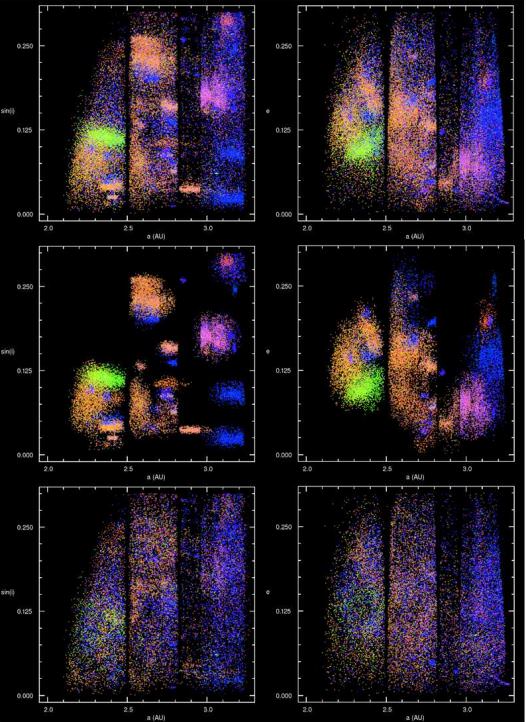
Who knew asteroids could be so beautiful and mesmerizing? In 2008, a group of astronomers led by Alex Parker did a study of the size distribution of asteroid families using data from the Sloan Digital Sky Survey. Asteroid families often have distinctive optical colors, the team said, and they were able to offer an improved way to separate out the family members into their colors. This resultant animation put together just this week by Parker shows the orbital motions of over 100,000 asteroids, with colors illustrating the compositional diversity and relative sizes of the asteroids.
“The compositional gradient of the asteroid belt is clearly visible,” says Parker, “with green Vesta-family members in the inner belt fading through the blue C-class asteroids in the outer belt, and the deep red Trojan swarms beyond that.”
All main-belt asteroids and Trojan asteroids with orbits known to high precision are shown in the video and the animation is rendered with a timestep of 3 days. Via Twitter, Parker said this animation took — from start to finish — 20 hours to render on 8 CPUs.
For reference, the average orbital distances of Mercury, Venus, Earth, Mars, and Jupiter are illustrated with rings.
Painted Stone: Asteroids in the Sloan Digital Sky Survey from Alex Parker on Vimeo.

